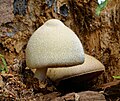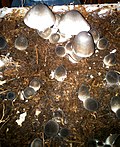Volvariella
| Volvariella | |
|---|---|

| |
| V. bombycina | |
| Scientific classification | |
| Domain: | Eukaryota |
| Kingdom: | Fungi |
| Division: | Basidiomycota |
| Class: | Agaricomycetes |
| Order: | Agaricales |
| Family: | Pluteaceae |
| Genus: | Volvariella Speg. (1898) |
| Type species | |
| Volvariella argentina Speg. (1898) | |
Volvariella is a genus of fungi with deep salmon pink gills and spore prints.
Description
The mushrooms lack a ring, and have an Amanita-like volva at the stem base. Some species of Amanita look similar, but Amanita has white spores and often have a ring. Since the gills of young Volvariella are white at first, they are more easily mistaken for Amanita. The genus is estimated to contain about 50 species.[1]
Taxonomy
Many sources list Volvariella as a member of the Pluteaceae family, but recent DNA studies have revealed that Pluteus and Volvariella evolved separately and have very different DNA. These studies show that Volvariella is very closely related to "schizophylloid" mushrooms like Schizophyllum commune.[2]
Species
| Image | Scientific name | Distribution |
|---|---|---|
 |
Volvariella bombycina | Iran, China, India, Korea, and Pakistan |
 |
Volvariella caesiotincta | Europe |
| Volvariella gloiocephala | Australia | |
 |
Volvariella hypopithys | |
| Volvariella indica | India[3] | |
| Volvariella iranica | Iran[4][5] | |
| Volvariella jamaicensis | ||
| Volvariella lepiotospora | ||
| Volvariella leucocalix | Brazil[6] | |

|
Volvariella media | Asia and Europe |
| Volvariella peckii | ||

|
Volvariella pusilla | Asia and Europe, North America, Africa and Australia |
| Volvariella sathei | India[7] | |
 |
Volvariella surrecta | North America north of Mexico, Northern Africa, Europe, New Zealand, and Asia |
| Volvariella variicystidiosa | Pakistan[8] | |
 |
Volvariella volvacea | East and Southeast Asia |
Uses
Volvariella volvacea, well known as the "paddy straw mushroom", is cultured in rice straw in the Philippines and Southeast Asia. This species also favors wood chip piles. It is easy to confuse with Amanita species such as A. phalloides (the death cap). This mistake is the leading cause of lethal mushroom poisoning in the United States. Volvariella and Amanita cannot be distinguished in the early "button stage", that, for many, is considered the best stage to collect Volvariella for consumption.[citation needed] Like Amanita, the paddy straw mushroom has a volva, or universal veil, so called because it is a membrane that encapsulates the entire mushroom when it is young; this structure breaks apart as the mushroom expands, leaving parts that can be found at the base of the stalk as a cup-like structure.
Some species of Volvariella are popular edibles in Europe, accounting for 16% of total production of cultivated mushrooms in the world.[citation needed]
References
- Key to the genus Volvariella [1]
- ^ Kirk PM, Cannon PF, Minter DW, Stalpers JA (2008). Dictionary of the Fungi (10th ed.). Wallingford, UK: CABI. p. 727. ISBN 978-0-85199-826-8.
- ^ Moncalvo JM, et al. (2002). "One hundred and seventeen clades of euagarics". Molecular Phylogenetics and Evolution. 23 (3): 357–400. Bibcode:2002MolPE..23..357M. doi:10.1016/S1055-7903(02)00027-1. PMID 12099793. Archived from the original on 2013-08-17. Retrieved 2007-01-11.
- ^ Kaur NJ, Saini MK, Kaur H (2013). "Two new species of agarics from India". Mycosphere. 4 (5): 856–863. doi:10.5943/mycosphere/4/5/1.
- ^ Fallahyan F. (1973). "Une nouvelle espèce de Volvaire: Volvaria iranica Fall. " (jpg). Revue de Mycologie (in French). 37 (5): 263.
- ^ Szczepka MZ, Sokól S (2000). "Systematyka i biologia Volvariella bombycina (Schaeff.: Fr.) Sing". Acta Biologica Silesiana (in Polish). 35 (52): 208–60 (see p. 210).
- ^ Sá, Mca (2016). "Volvariella leucocalix (Pluteaceae), a new species from Brazilian semiarid region" (PDF). Mycosphere. 7 (1): 30–35. doi:10.5943/mycosphere/7/1/3.
- ^ Senthilarasu G, Sharma R, Singh SK (2012). "A new species of Volvariella from India". Mycotaxon. 119: 467–76. doi:10.5248/119.467.
- ^ Haqnawaz, M., Khan, Z., Niazi, A. R., & Khalid, A. N. (2023). Volvariella variicystidiosa sp. nov. (Agaricaceae, Basidiomycota) from Punjab, Pakistan. Phytotaxa, 578(2), 189-198. https://doi.org/10.11646/phytotaxa.578.2.5
